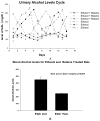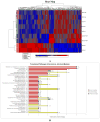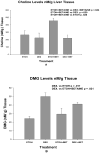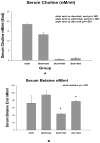Betaine feeding prevents the blood alcohol cycle in rats fed alcohol continuously for 1 month using the rat intragastric tube feeding model
- PMID: 21708146
- PMCID: PMC3185137
- DOI: 10.1016/j.yexmp.2011.05.009
Betaine feeding prevents the blood alcohol cycle in rats fed alcohol continuously for 1 month using the rat intragastric tube feeding model
Abstract
Background: Blood alcohol levels (BAL) cycle up and down over a 7-8 day period when ethanol is fed continuously for one month in the intragastric tube feeding rat model (ITFRM) of alcoholic liver disease. The cycling phenomenon is due to an alternating increase and decrease in the metabolic rate. Recently, we found that S-adenosyl-methionine (SAMe) fed with alcohol prevented the BAL cycle.
Method: Using the ITFRM we fed rats betaine (2 g/kg/day) with ethanol for 1 month and recorded the daily 24 h urine ethanol level (UAL) to measure the BAL cycle. UAL is equivalent to BAL because of the constant ethanol infusion. Liver histology, steatosis and BAL were measured terminally after 1 month of treatment. Microarray analysis was done on the mRNA extracted from the liver to determine the effects of betaine and alcohol on changes in gene expression.
Results: Betaine fed with ethanol completely prevented the BAL cycle similar to SAMe. Betaine also significantly reduced the BAL compared to ethanol fed rats without betaine. This was also observed when SAMe was fed with ethanol. The mechanism involved in both cases is that SAMe is required for the conversion of epinephrine from norepinephrine by phenylethanolamine methyltransferase (PNMT). Epinephrine is 5 to 10 fold more potent than norepinephrine in increasing the metabolic rate. The increase in the metabolic rate generates NAD, permitting ADH to increase the oxidation of alcohol. NAD is the rate limiting factor in oxidation of alcohol by alcohol dehydrogenase (ADH). This explains how SAMe and betaine prevented the cycle. Microarray analysis showed that betaine feeding prevented the up regulation of a large number of genes including TLR2/4, Il-1b, Jax3, Sirt3, Fas, Ifngr1, Tgfgr2, Tnfrsf21, Lbp and Stat 3 which could explain how betaine prevented fatty liver.
Conclusion: Betaine feeding lowers the BAL and prevents the BAL cycle by increasing the metabolic rate. This increases the rate of ethanol elimination by generating NAD.
Copyright © 2011 Elsevier Inc. All rights reserved.
Figures









Similar articles
-
How to prevent alcoholic liver disease.Exp Mol Pathol. 2015 Apr;98(2):304-7. doi: 10.1016/j.yexmp.2015.03.007. Epub 2015 Mar 7. Exp Mol Pathol. 2015. PMID: 25758202 Free PMC article. Review.
-
The pathogenesis and significance of the urinary alcohol cycle in rats fed ethanol intragastrically.Alcohol Clin Exp Res. 2005 Nov;29(11 Suppl):158S-161S. Alcohol Clin Exp Res. 2005. PMID: 16344601 Review.
-
The cyclic pattern of blood alcohol levels during continuous ethanol feeding in rats: the effect of feeding S-adenosylmethionine.Exp Mol Pathol. 2010 Jun;88(3):380-7. doi: 10.1016/j.yexmp.2010.03.004. Epub 2010 Mar 17. Exp Mol Pathol. 2010. PMID: 20303346 Free PMC article.
-
Mechanism of the alcohol cyclic pattern: role of catecholamines.Am J Physiol Gastrointest Liver Physiol. 2003 Aug;285(2):G442-8. doi: 10.1152/ajpgi.00093.2003. Epub 2003 Apr 17. Am J Physiol Gastrointest Liver Physiol. 2003. PMID: 12702493
-
The effect of rotenone on the urinary ethanol cycle in rats fed ethanol intragastrically.Exp Mol Pathol. 2004 Dec;77(3):210-3. doi: 10.1016/j.yexmp.2004.08.005. Exp Mol Pathol. 2004. PMID: 15507238
Cited by
-
Studies on the functional role of UFMylation in cells (Review).Mol Med Rep. 2025 Jul;32(1):191. doi: 10.3892/mmr.2025.13556. Epub 2025 May 9. Mol Med Rep. 2025. PMID: 40341950 Free PMC article. Review.
-
Rectification of impaired adipose tissue methylation status and lipolytic response contributes to hepatoprotective effect of betaine in a mouse model of alcoholic liver disease.Br J Pharmacol. 2014 Sep;171(17):4073-86. doi: 10.1111/bph.12765. Epub 2014 Jul 2. Br J Pharmacol. 2014. PMID: 24819676 Free PMC article.
-
Folate, alcohol, and liver disease.Mol Nutr Food Res. 2013 Apr;57(4):596-606. doi: 10.1002/mnfr.201200077. Epub 2012 Nov 8. Mol Nutr Food Res. 2013. PMID: 23136133 Free PMC article. Review.
-
How to prevent alcoholic liver disease.Exp Mol Pathol. 2015 Apr;98(2):304-7. doi: 10.1016/j.yexmp.2015.03.007. Epub 2015 Mar 7. Exp Mol Pathol. 2015. PMID: 25758202 Free PMC article. Review.
-
Mallory-Denk Body (MDB) formation modulates Ufmylation expression epigenetically in alcoholic hepatitis (AH) and non-alcoholic steatohepatitis (NASH).Exp Mol Pathol. 2014 Dec;97(3):477-83. doi: 10.1016/j.yexmp.2014.10.001. Epub 2014 Oct 5. Exp Mol Pathol. 2014. PMID: 25290169 Free PMC article.
References
-
- Barak AJ, Beckenhauer HC, Junnia M, Tuma DJ. Dietary betaine promotes generation of hepatitic adenosylmethionine and protects the liver from ethanol-induced fatty infiltration. Alcoholism Clin Exp Res. 1993;17:552–555. - PubMed
-
- Bardag-Gorce F, French BA, Dedes J, Li J, French SW. Gene expression patterns of the liver in response to alcohol: in vivo and in vitro models compared. Exp Molec Pathol. 2006;80:241–251. - PubMed
-
- Bardag-Gorce F, French BA, Li J, Riley NE, Yuan QX, Reitz R, Cai Y, Wan YJY, French SW. The importance of cycling of blood alcohol levels in the pathogenesis of experimental alcoholic liver disease in rats fed ethanol intragastrically. Gastroenterology. 2002;123:325–335. - PubMed
Publication types
MeSH terms
Substances
Grants and funding
LinkOut - more resources
Full Text Sources
Research Materials
Miscellaneous

